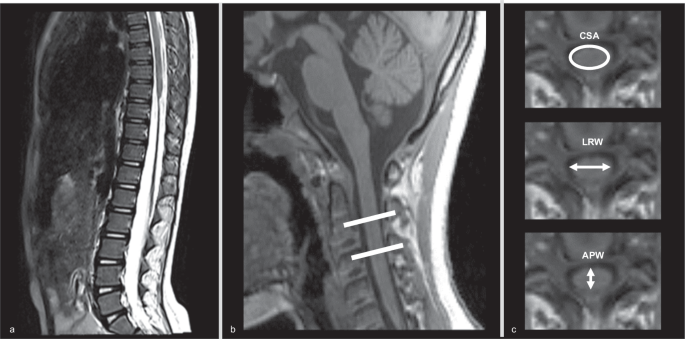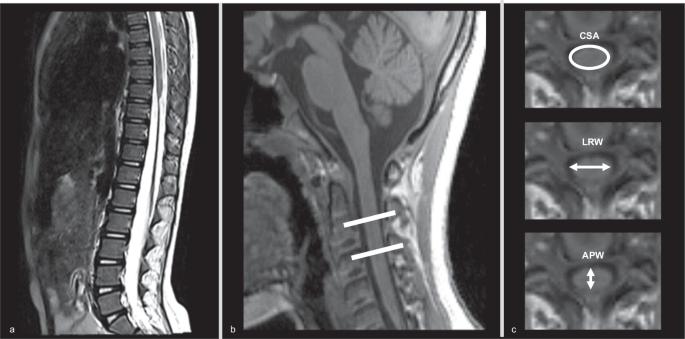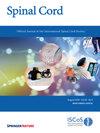胸腰椎脊髓损伤(TLSCI)儿童颈脊髓结构变化与感觉运动功能之间的关系。
IF 2.1
4区 医学
Q3 CLINICAL NEUROLOGY
引用次数: 0
摘要
研究设计横断面研究:研究创伤性胸腰椎脊髓损伤(TLSCI)患儿颈脊髓(C2/3水平)结构改变与感觉运动功能的关系,并发现评估其功能状态的客观影像学生物标志物:方法:本研究招募了30名创伤性胸腰椎脊髓损伤(TLSCI)儿童(5-13岁)和11名发育典型(TD)儿童(6-12岁)。根据损伤神经水平(NLI)以下是否保留运动功能,TLSCI患儿被分为AIS A/B组(运动完全)和AIS C/D组(运动不完全)。使用西门子Verio 3.0 T磁共振扫描仪采集涵盖头部和上颈部脊髓的三维高分辨率解剖扫描图像。使用脊髓工具箱(SCT; https://www.nitrc.org/projects/sct )获得了C2/3水平脊髓的形态学参数,包括横截面积(CSA)、前后宽度(APW)和左右宽度(LRW)。对脊髓形态学参数和脊髓损伤神经学分类国际标准(ISNCSCI)检查确定的临床评分进行了相关性分析比较:结果:AIS A/B组的CSA和LRW明显低于TD组和AIS C/D组。LRW 是区分 AIS A/B 组和 AIS C/D 组最敏感的影像生物标志物。CSA和APW均与ISNCSCI感觉评分呈正相关:颈脊髓形态学参数的定量测量可作为评估 TLSCI 儿童神经功能的客观影像生物标志物。TLSCI患儿的颈脊髓萎缩与临床分级相关;CSA和APW可反映感觉功能。同时,LRW有可能成为评估运动功能保存情况的客观成像生物标志物。本文章由计算机程序翻译,如有差异,请以英文原文为准。


The relationship between the structural changes in the cervical spinal cord and sensorimotor function of children with thoracolumbar spinal cord injury (TLSCI)
Cross-sectional study. To study the relationship between the structural changes in the cervical spinal cord (C2/3 level) and the sensorimotor function of children with traumatic thoracolumbar spinal cord injury (TLSCI) and to discover objective imaging biomarkers to evaluate its functional status. Xuanwu Hospital, Capital Medical University, China; Beijing Key Laboratory of Magnetic Resonance Imaging and Brain Informatics, China. 30 children (age range 5–13 years) with TLSCI and 11 typically developing (TD) children (age range 6–12 years) were recruited in this study. Based on whether there is preserved motor function below the neurological level of injury (NLI), the children with TLSCI are divided into the AIS A/B group (motor complete) and the AIS C/D group (motor incomplete). A Siemens Verio 3.0 T MR scanner was used to acquire 3D high-resolution anatomic scans covering the head and upper cervical spinal cord. Morphologic parameters of the spinal cord at the C2/3 level, including cross-sectional area (CSA), anterior-posterior width (APW), and left-right width (LRW) were obtained using the spinal cord toolbox (SCT; https://www.nitrc.org/projects/sct ). Correlation analyses were performed to compare the morphologic spinal cord parameters and clinical scores determined by the International Standard for Neurological Classification of Spinal Cord Injuries (ISNCSCI) examination. CSA and LRW in the AIS A/B group were significantly lower than those in the TD group and the AIS C/D group. LRW was the most sensitive imaging biomarker to differentiate the AIS A/B group from the AIS C/D group. Both CSA and APW were positively correlated with ISNCSCI sensory scores. Quantitative measurement of the morphologic spinal cord parameters of the cervical spinal cord can be used as an objective imaging biomarker to evaluate the neurological function of children with TLSCI. Cervical spinal cord atrophy in children after TLSCI was correlated with clinical grading; CSA and APW can reflect sensory function. Meanwhile, LRW has the potential to be an objective imaging biomarker for evaluating motor function preservation.
求助全文
通过发布文献求助,成功后即可免费获取论文全文。
去求助
来源期刊

Spinal cord
医学-临床神经学
CiteScore
4.50
自引率
9.10%
发文量
142
审稿时长
2 months
期刊介绍:
Spinal Cord is a specialised, international journal that has been publishing spinal cord related manuscripts since 1963. It appears monthly, online and in print, and accepts contributions on spinal cord anatomy, physiology, management of injury and disease, and the quality of life and life circumstances of people with a spinal cord injury. Spinal Cord is multi-disciplinary and publishes contributions across the entire spectrum of research ranging from basic science to applied clinical research. It focuses on high quality original research, systematic reviews and narrative reviews.
Spinal Cord''s sister journal Spinal Cord Series and Cases: Clinical Management in Spinal Cord Disorders publishes high quality case reports, small case series, pilot and retrospective studies perspectives, Pulse survey articles, Point-couterpoint articles, correspondences and book reviews. It specialises in material that addresses all aspects of life for persons with spinal cord injuries or disorders. For more information, please see the aims and scope of Spinal Cord Series and Cases.
 求助内容:
求助内容: 应助结果提醒方式:
应助结果提醒方式:


